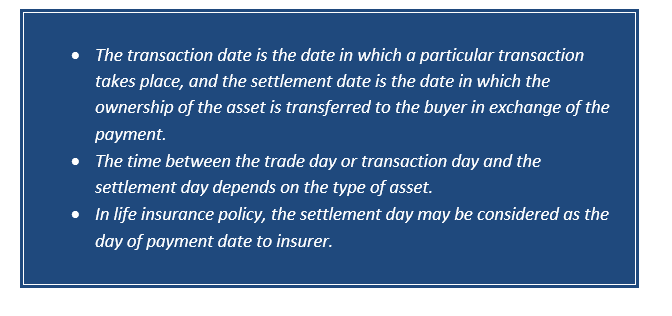What is the Settlement Day?
The Settlement Day is the date on which the trade or derivative contract is settled when the buyer makes payment to the seller while the seller transfers the ownership of the assets to the buyer. The time between the trade day or transaction day and the settlement day depends on the type of asset. The settlement day for stocks, bonds And Spot foreign exchange (FX) is generally two business days after the transaction date (T+2), while for the government security such as treasury bill settlement day is the next business day to transaction day (T+1). Derivative contracts also have settlement dates for trades in addition to a contract’s expiration dates.
The settlement day does not include Saturdays, Sundays, exchange and bank holidays and is governed by the Securities Exchange Commission (SEC). The two main dates are to consider while transaction of securities that are transaction date or trade date and the settlement date.

© 2021 Kalkine Media®
The Transaction date is the date in which a particular transaction takes place, and the settlement date is the date in which the ownership of the asset is transferred to the buyer in exchange of the payment, on which the transaction is finalized. Both the dates do not take place on same day as it takes time to make payment and transfer ownership of the assets. The regulators of the stock exchange have set a time frame between the buyer and seller in which they need to settle the trade. In life insurance policy, the settlement day may be considered as the day of payment date to insurer.

Understanding Settlement Day
Previously, the assets or securities are transferred manually through post mail and the buyer use to make payment only when they have received the certificate of ownership and due to different delivery period, it was common for price of securities to fluctuate between the trade day and settlement day. Previously, trade use to take five business day after trade day to settle a trade (T+5).
However, introduction of innovative technology has reduced the time between both the dates.
The stock exchange specifies the number of days after a transaction takes place and the asset to be delivered to buyer, which lags between the trade day and settlement day follows how settlement were previously confirmed, by physical delivery. But holidays and weekends can increase the time between the trade and settlement day.
In the foreign exchange market, both the countries need to have the settlement day, a valid business day and in the forward foreign exchange contracts are settled on business day that is beyond the spot value date. There are no restrictions in how far the forward and future trade can settle but credit lines are usually limited to one year.
Settlement Day Risks
The time between the trade day and settlement day expose the buyer and sellers to the two types of risks.
- Credit Risk
Credit risk is the risk of loss due to buyer’s incompetence to meet the contractual commitments in the trade due to the time difference between trade and settlement date and volatility in the stock market due to interruption of cash flow the buyer may fail to make the payment to the seller.
- Settlement Risk
Settlement risk occurs when the buyer or seller fails to fulfill their commitments to the transaction with the other party. It usually occurs when the seller fails to transfer ownership of the securities to the buyer in exchange of the payment.
Further, the settlement risk may also occur when the buyer fails to make payment to the seller in exchange of the security.
In the foreign market, the settlement risk may also occur when the currencies are not transferred or paid at the same time, due to difference in time zones and geography.
Life Insurance Settlement Day
In case of the death of insurer, the life insurance policy allows payment unless the policy has been cashed out or surrendered. If the policy has multiple beneficiaries the payment takes longer time due to delay in contract and general processing. Whereas, in case of single beneficiary, the payment generally take two weeks from the receipt of death certificate. In most cases the insurer need to pay interest settlement of policy takes time.
 Please wait processing your request...
Please wait processing your request...